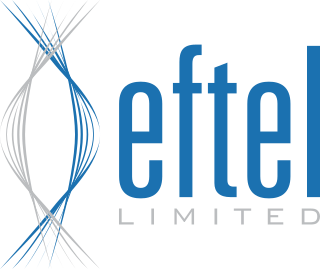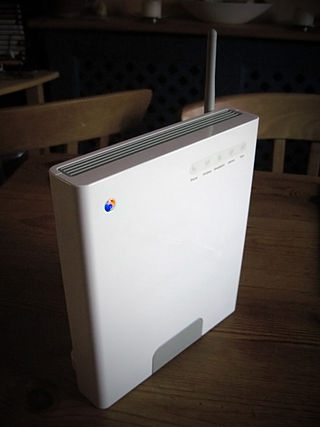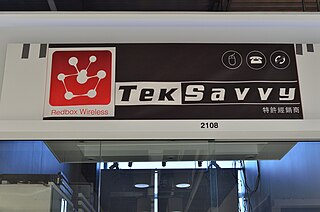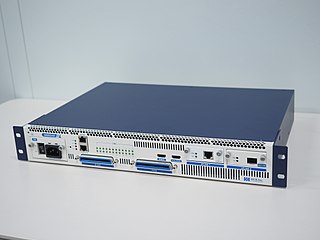Related Research Articles
Digital subscriber line is a family of technologies that are used to transmit digital data over telephone lines. In telecommunications marketing, the term DSL is widely understood to mean asymmetric digital subscriber line (ADSL), the most commonly installed DSL technology, for Internet access.
Very high-speed digital subscriber line (VDSL) and very high-speed digital subscriber line 2 (VDSL2) are digital subscriber line (DSL) technologies providing data transmission faster than the earlier standards of asymmetric digital subscriber line (ADSL) G.992.1, G.992.3 (ADSL2) and G.992.5 (ADSL2+).

Bell Internet, originally and frequently still called Sympatico, is the residential Internet service provider (ISP) division of BCE Inc. As of May 3, 2012, Bell Internet had over 3 million subscribers in Ontario and Quebec, making it the largest ISP in Canada.
Rate-adaptive digital subscriber line (RADSL) is a pre-standard asymmetric digital subscriber line (ADSL) solution. RADSL was introduced as proprietary technology by AT&T Paradyne, later GlobeSpan Technologies Inc., in June 1996. In September 1999, RADSL technology was formally described by ANSI in T1.TR.59-1999. RADSL supports downstream data rates of up to approximately 8 Mbit/s, upstream data rates up to approximately 1 Mbit/s, and can coexist with POTS voice on the same line.
A naked DSL, also known as standalone or dry loop DSL, is a digital subscriber line (DSL) without a PSTN service — or the associated dial tone. In other words, only a standalone DSL Internet service is provided on the local loop.
The 21st Century Network (21CN) programme is the data and voice network transformation project, under way since 2004, of the UK telecommunications company BT Group plc. It was intended to move BT's telephone network from the AXE/System X Public Switched Telephone Network (PSTN) to an Internet Protocol (IP) system. As well as switching over the PSTN, BT planned to deliver many additional services over their new data network, such as on-demand interactive TV services.

Eftel Limited was an internet service provider and telecommunications provider in Australia, with approximately 120,000 active accounts. It was established in 1999. Eftel offers a range of services including: DSL and dial-up Internet access, web hosting and telephony services - to the retail, corporate and wholesale telecommunications markets.
Whidbey Telecom is a private, independent telecommunications company operating on the South End of Whidbey Island in Washington State, the community of Point Roberts, Washington, and its affiliate Hat Island Telephone Company on Hat (Gedney) Island. Whidbey Telecom has been locally owned and operated since it started business in 1908.

The BT Smart Hub is a family of wireless residential gateway router modems distributed by BT for use with their own products and services and those of wholesale resellers but not with other Internet services. Since v 5 Home/Smart Hubs support the faster Wi-Fi 802.11ac standard, in addition to the 802.11b/g/n standards. All models of the Home Hub prior to Home Hub 3 support VoIP Internet telephony via BT's Broadband Talk service, and are compatible with DECT telephone handsets. Since the Home Hub 4, all models have been dual band.
Internet access is widely available in New Zealand, with 94% of New Zealanders having access to the internet as of January 2021. It first became accessible to university students in the country in 1989. As of June 2018, there are 1,867,000 broadband connections, of which 1,524,000 are residential and 361,000 are business or government.
The prevalent means of connecting to the Internet in Germany is DSL, introduced by Deutsche Telekom in 1999. Other technologies such as Cable, FTTH and FTTB (fiber), Satellite, UMTS/HSDPA (mobile) and LTE are available as alternatives.
Internet in France has been available to the general public since 1994, but widespread Internet use did not take off until the mid-2000s. As of 31 December 2014, France had 26 million Internet broadband and high-speed connections on fixed networks. In 2014, 80.7% of French households had Internet access, while 19.3% did not.
Broadband Internet in Israel has been available since the late 1990s in theory, but it only became practically accessible to most customers in 2001. By 2008, Israel had become one of the few countries with developed broadband capabilities across two types of infrastructure—cable and DSL—reaching over 95% of the population. Actual broadband market penetration stands at 77%, ranked 7th in the world. In 2010, Israel was ranked 26th in The Economist's Digital Economy Rankings. In 2022, Israel was ranked first for digital quality of life by Surfshark.
The Broadband Forum is a non-profit industry consortium dedicated to developing broadband network specifications. Members include telecommunications networking and service provider companies, broadband device and equipment vendors, consultants and independent testing labs (ITLs). Service provider members are primarily wire-line service providers (non-mobile) telephone companies.
2Wire, Inc., was a home networking Customer Premises Equipment (CPE) manufacturer that provided telecommunications companies with hardware, software, service platforms, and remote CPE management systems. The company was headquartered in San Jose, California, in the Silicon Valley. The company had employed approximately 1,600 employees globally, including 550 in R&D, sales and administration, 450 in customer care and 600 agency employees in five U.S. offices and an additional nine offices around the world by July 2010. The 2Wire HomePortal residential gateways were distributed by broadband service providers such as AT&T, Embarq, windstream and Qwest in the United States, Bell in Canada, Telmex in Mexico, BT Group in the United Kingdom, Telstra in Australia and SingTel in Singapore. In July 2010, Pace plc of the United Kingdom agreed to buy 2Wire for $475m (£307m).
Sonic is a telecommunications company and internet service provider based in Santa Rosa, California, acting as a competitive local exchange carrier in the San Francisco Bay Area, Sacramento, and Los Angeles.

TekSavvy Solutions Inc. (TSI) is a Canadian residential, business, and wholesale telecommunications company based in Chatham, Ontario. In most of the country, it is a wholesale-network-access-based service provider and voice reseller, connecting its service to existing last mile networks from telecom carriers Bell Canada and Telus Communications, and cable carriers Rogers Communications, Cogeco Cable, Shaw and Vidéotron. However, in parts of rural southwestern Ontario, the service is provided over TekSavvy's own fixed wireless network. Recently they have also rolled out their own fibre optic network in parts of southwestern Ontario.
Chorus is a provider of telecommunications infrastructure throughout New Zealand. It is listed on the NZX stock exchange and is in the NZX 50 Index. The company owns the majority of telephone lines and exchange equipment in New Zealand; and was responsible for building approximately 70% of the country's fibre-optic UFB network, receiving a government subsidy of $929 million to do so.

G.fast is a digital subscriber line (DSL) protocol standard for local loops shorter than 500 meters, with performance targets between 100 Mbit/s and 1 Gbit/s, depending on loop length. High speeds are only achieved over very short loops. Although G.fast was initially designed for loops shorter than 250 meters, Sckipio in early 2015 demonstrated G.fast delivering speeds over 100 Mbit/s at nearly 500 meters and the EU announced a research project.

AT&T Internet is an AT&T brand of broadband internet service. Previously, AT&T Internet was branded as U-verse Internet and bundled with U-verse TV, which was spun off into the newly independent DirecTV in 2021. AT&T Internet plans powered by fiber-optic cable use the AT&T Fiber brand.
References
- ↑ William L. Abbott and Peter Chow (January 24, 2005). "VDSL2 and UDSL – Ultra High Speed DSL Technologies for FTTN Deployment". Converge Network Digest. Archived from the original on 2007-03-12. Retrieved September 22, 2011.
- ↑ Douglas Chrissan (June 28, 2004). "Uni-DSL™: One DSL for Universal Service" (PDF). Retrieved September 22, 2011.
- ↑ "TI Proposal to Unify DSL Standards Paves the Way for Competitive Video Services from Telecom". News release. Texas Instruments. June 14, 2004. Archived from the original on August 4, 2004. Retrieved September 22, 2011.